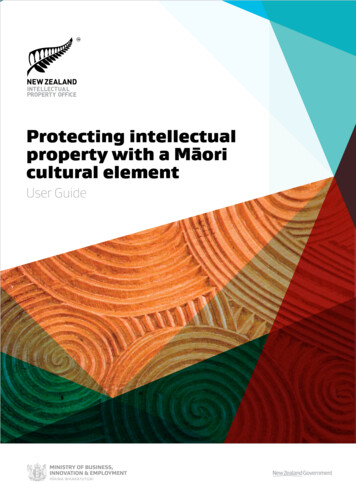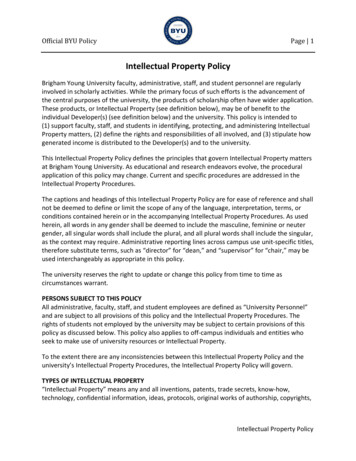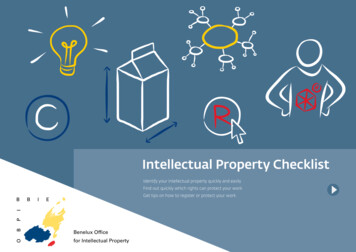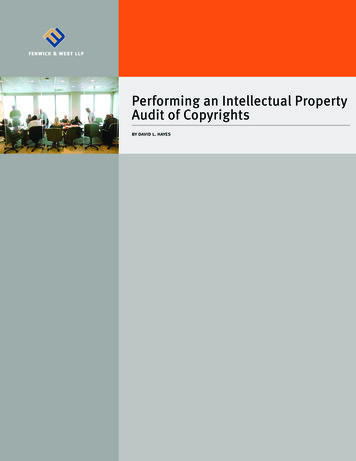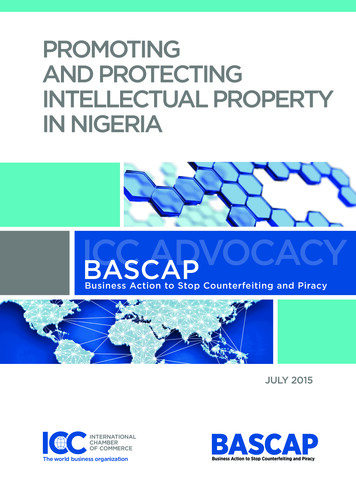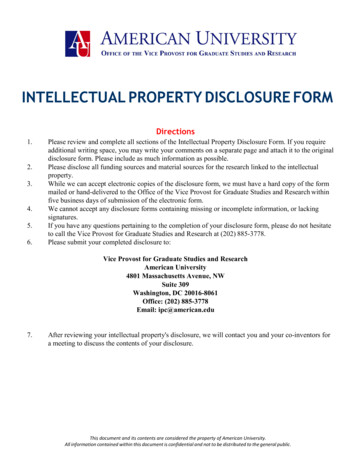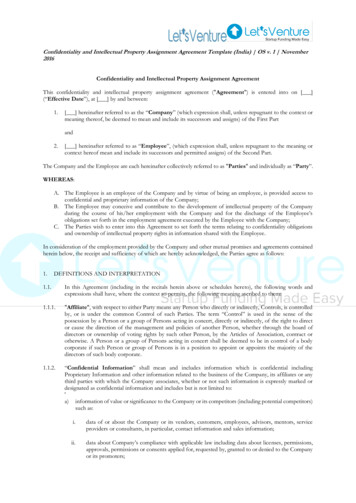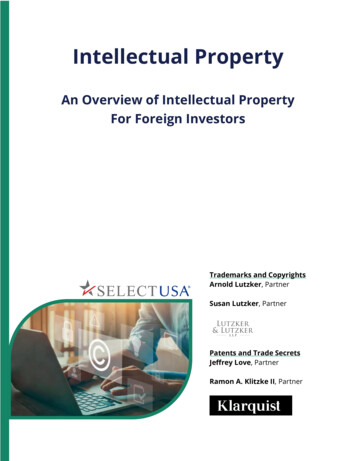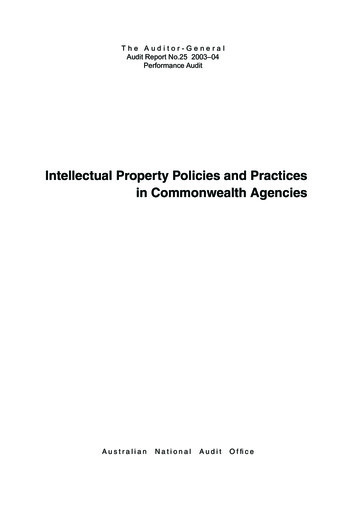
Transcription
The Auditor-GeneralAudit Report No.25 2003–04Performance AuditIntellectual Property Policies and Practicesin Commonwealth AgenciesAustralianNationalAuditO f fi c e
Commonwealthof Australia 2004ISSN 1036–7632ISBN 0 642 80755 8COPYRIGHT INFORMATIONThis work is copyright. Apart fromany use as permitted under theCopyright Act 1968, no part may bereproduced by any process withoutprior written permission from theCommonwealth available from theDepartment of Communications,Information Technology and the Arts.Requests and inquiries concerningreproduction and rights should beaddressed to the CommonwealthCopyright Administration,Intellectual Property Branch,Department of Communications,Information Technology and the Arts,GPO Box 2154Canberra ACT 2601 or posted athttp://www.dcita.gov.au/cca2Report No.25 2003–04Intellectual Property Policies and Practices in Commonwealth Agencies
Canberra ACT5 February 2004Dear Mr PresidentDear Mr SpeakerThe Australian National Audit Office has undertaken a performance audit acrossagencies in accordance with the authority contained in the Auditor-General Act1997. Pursuant to Senate Standing Order 166 relating to the presentation ofdocuments when the Senate is not sitting, I present the report of this audit andthe accompanying brochure. The report is titled Intellectual Property Policiesand Practices in Commonwealth Agencies.Following its presentation and receipt, the report will be placed on the AustralianNational Audit Office’s Homepage—http://www.anao.gov.au.Yours SincerelyP. J. BarrettAuditor-GeneralThe Honourable the President of the SenateThe Honourable the Speaker of the House of RepresentativesParliament HouseCanberra ACTReport No.25 2003–04Intellectual Property Policies and Practices in Commonwealth Agencies3
AUDITING FOR AUSTRALIAThe Auditor-General is head of theAustralian National Audit Office. TheANAO assists the Auditor-General tocarry out his duties under the AuditorGeneral Act 1997 to undertakeperformance audits and financialstatement audits of Commonwealthpublic sector bodies and to provideindependent reports and advice forthe Parliament, the Governmentand the community. The aim is toimprove Commonwealth public sectoradministration and accountability.For further information contact:The Publications ManagerAustralian National Audit OfficeGPO Box 707Canberra ACT 2601Telephone:Fax:Email:(02) 6203 7505(02) 6203 7519webmaster@anao.gov.auANAO audit reports and informationabout the ANAO are available at ourinternet address:http://www.anao.gov.auAudit TeamDavid NyskohusEe-Ling ThenDr Paul Nicoll4Report No.25 2003–04Intellectual Property Policies and Practices in Commonwealth Agencies
ContentsAbbreviationsGlossary79Summary and Recommendations15SummaryAudit objective and methodologyKey FindingsOverall ConclusionAgency ResponsesRecommendations171819222324Audit Findings and Conclusions251. IntroductionAudit approachWhat is intellectual property?What is intellectual property management?Intellectual property management in the CommonwealthIntellectual property policy arrangements in the CommonwealthA framework for intellectual property management2. Leadership and Corporate SupportBackgroundFindingsSummary3. Identifying Intellectual PropertyBackgroundFindingsSummary4. Managing OwnershipBackgroundFindingsSummary5. Monitoring and ProtectionBackgroundFindingsSummary6. IP Transfer and UptakeBackgroundFindingsSummary7. Evaluation and ReportingBackgroundFindingsSummary8. A Framework and Better Practice Principles for Intellectual 1636869697377787878848585869192929396Report No.25 2003–04Intellectual Property Policies and Practices in Commonwealth Agencies971025
Appendices103Appendix 1: Agencies covered by the auditAppendix 2: Intellectual property management publicationsAppendix 3: Better Practice PrinciplesAppendix 4: Agency general responses to the draft audit report105107110113Series TitlesBetter Practice Guides1151176Report No.25 2003–04Intellectual Property Policies and Practices in Commonwealth Agencies
AbbreviationsAASBAustralian Accounting Standards BoardABSAustralian Bureau of StatisticsACIPAAustralian Centre for Intellectual Property inAgricultureACTAustralian Capital cesAirservices AustraliaANAOAustralian National Audit OfficeANSTOAustralian Nuclear Science and TechnologyOrganisationAPECAsia-Pacific Economic Co-operationCAC ActCommonwealth Authorities and Companies Act 1997CSIROCommonwealth Scientific and Industrial ResearchOrganisationDefenceDepartment of DefenceDSTODefence Science and Technology OrganisationDEWRDepartment of Employment and Workplace RelationsDCITADepartment of Communications, InformationTechnology and the ArtsDRMDigital Rights ManagementFMA ActFinancial Management and Accountability Act 1997GRDCGrains Research and Development CorporationHRHuman resourcesIPIntellectual propertyIPNAIntellectual property needs analysisIPPSCIntellectual Property Policy and Support CentreIPRIAIntellectual Property Research Institute of AustraliaIT–IPInformation technology–intellectual propertyNSWNew South WalesNTNorthern TerritoryOECDOrganisation for Economic Co-operation andDevelopmentPMCPatent Management CommitteeReport No.25 2003–04Intellectual Property Policies and Practices in Commonwealth Agencies7
QldQueenslandRFTRequest for tenderSASouth AustraliaT2COTechnology Transfer and Commercialisation OfficeTasTasmaniaTPMsTechnological Protection MeasuresVicVictoriaWAWestern Australia8Report No.25 2003–04Intellectual Property Policies and Practices in Commonwealth Agencies
GlossaryAssignmentA formal transfer of ownership. In the case ofintellectual property rights created by legislation,assignments are generally required to be inwriting.Background IPBackground intellectual property refers toall existing material that is brought into arelationship or transaction. It may form the basison which new, foreground intellectual property isestablished (see—Foreground IP).Circuit Layout RightsThe Circuit Layouts Act 1989 provides copyrightstyle protection for the layout design used tobuild an integrated circuit or computer chip. Likecopyright protection, circuit layout protection isautomatic.CommercialisationThe process of taking IP to the marketplaceusually through the incorporation into a productor service or through the sale or licensing of IP forcommercial gain.ConfidentialInformationConfidential information refers to proprietaryinformation that is kept secret (in the generallyaccepted use of the term) (for example, tradesecrets and know-how) and is not available in thepublic domain. Confidential information is notprotected by statute, but by the common law andequity. An agency possessing such informationcan restrain the unauthorised disclosure ofthat information through an action for breachof confidentiality, in addition to any action forbreach of contractual confidentiality obligations.In certain instances, misuse of confidentialinformation may also breach a statutoryrestriction.Report No.25 2003–04Intellectual Property Policies and Practices in Commonwealth Agencies9
CopyrightCopyright protection is provided by the CopyrightAct 1968. The Act prohibits the unauthorisedreproduction or dissemination of information asexpressed in a ‘material form’. Copyright mayexist in many works produced in the course ofthe normal operations of agencies, for example,software, reports, publications, blueprints, andcomponents of training programs (manuals,videos, notes). However, not all works protectedby copyright will be commercially significant.Copyright protection is automatic. Nothingneeds to be done to obtain copyright protection,and protection commences as soon as copyrightmaterial is created. Copyright protects the originalexpression of ideas, not the ideas themselves.Crown copyrightThe Copyright Act makes special provision for theownership of copyright materials by departmentsof government and some government agencies(referred in the Act as the “Crown”). The Actprovides that the Crown is the owner of copyrightin original work made, or first published, “byor under the direction or control of” the Crown(subject to any agreement assigning that copyrightto another).DesignsThe Designs Act 1906 (soon to be replaced bythe Designs Act 2003) provides protection forthe visual appearance of a manufactured article,provided that appearance is new or original.Design rights are not automatic but requireregistration.Digital RightsManagementDigital Rights Management (DRM) refers to thewide range of systems and services that are usedfor the description, identification, protection,monitoring and tracking of all forms of digitalcopyright material throughout the lifecycle of thematerial.10Report No.25 2003–04Intellectual Property Policies and Practices in Commonwealth Agencies
Abbreviations/GlossaryForeground IPForeground intellectual property refers to newlycreated IP (also known as derivative material)that can be developed from scratch or from preexisting Background IP. Foreground IP usuallyresults from performance of a contract (forexample, under a collaboration or service deliveryarrangement).Intellectual propertyIntellectual property (IP) refers to the rightsgranted by law in relation to the fruits of humanintellectual (as distinct from physical) activity.It includes all copyright, all rights in relationto inventions (including patent rights), plantvarieties, registered and unregistered trade marks(including service marks), registered designs,circuit layouts, confidential information and allother rights resulting from intellectual activity inthe industrial, scientific, literary or artistic fields.IP AustraliaThe Commonwealth Government agency thatadministers patents, trade marks and designrights within Australia. IP Australia is part of theIndustry, Tourism and Resources Portfolio.IP Management PlanFor the purposes of this audit, IP ManagementPlan refers to the formal plan or plans, proceduresor practices by which an agency will manage its IP.Where an agency has adopted an IP Policy, the IPManagement Plan will usually detail the means bywhich the agency will implement the IP Policy.IP PolicyFor the purposes of this audit, an IP Policy refersto a formal agency statement, usually endorsedby the agency CEO, executive or board, outliningthe course of action to be taken by the agency inmanaging its IP. The IP Policy may also includethe agency’s IP Management Plan (see—IPManagement Plan).Report No.25 2003–04Intellectual Property Policies and Practices in Commonwealth Agencies11
(To) LicenseTo grant permission to use IP rights associatedwith an IP asset. The extent and scope of alicence should preferably be settled in a licensingagreement, although in some instances a licencemay be inferred or implied from the circumstancesin which the material is made available. Astatutory licence is a provision in legislation (forexample, as in the Copyright Act) that allows theexercise of certain intellectual property rights inspecified circumstances without requiring theexpress permission of the right holder.PatentsThe Patents Act 1990 protects the rights ininventions that are useful, novel and not obviousto people skilled in the relevant field. Theinvention can be a new product or process orimprovements to existing products or processes.Business systems and computer programs cannow also be patented.Patent protection is obtained by applying for apatent through IP Australia (see—IP Australia).Inventions must usually be kept secret until anapplication for a patent is lodged to be properlyprotected. Once a patent is granted, the patenteehas the exclusive right to exploit the invention fora limited period.Plant Breeder’s Rights Plant Breeder’s Rights are provided by the PlantBreeder’s Rights Act 1994 and protect new varietiesof plants, fungal and algal species and transgenicplants, provided that the new variety is distinct,uniform and stable.Plant Breeder’s Rights are not automatic butrequire registration with the Plant Breeder’sRights Office in the Department of Agriculture,Fisheries, Forestry—Australia.12Report No.25 2003–04Intellectual Property Policies and Practices in Commonwealth Agencies
Abbreviations/GlossaryProtectionThe various forms of IP (copyright, patents, etc.)provide a complex system of legal protections.A single asset may be the subject of protectionunder more than one regime and this may presentdifficult choices as to the form of protectionon which to rely. For example, an originallydeveloped computer program (including thesource and object code) would be protected bycopyright but may also be protected by imposingconfidentiality restrictions on disclosure of thecomputer program and/or by seeking patentprotection for any new or novel aspects of thecomputer program.SystemFor the purposes of this audit, a system for themanagement of IP may include formal or informalplans, procedures or practices by which an agencymanages IP under its direction or control.Third party IPIntellectual property used by an agency that is notowned by that agency. Such IP would normally beused by the agency under voluntary or statutorylicence.Trade marksA trade mark is a sign used to distinguish goodsor services of one trader from those of another.Trade mark protection can be obtained throughthe Trade Marks Act 1995.Once a mark is registered with IP Australia, thereare limitations on the ability of others to use thesame or a similar mark.Note, however, that even where a mark is notregistered, it may be possible for its owner to takeaction under the common law or under tradepractices legislation to prevent others from usingit in a deceptive way, though generally only wherethe mark has become distinctively associated withthe owner.UptakeThe diffusion, commercialisation or transfer of anagency’s intellectual property to another party.Report No.25 2003–04Intellectual Property Policies and Practices in Commonwealth Agencies13
ValueAn IP asset may be of operational, commercial orpublic value. An IP asset may be operationallyvaluable if it plays an important role in theoperations of, or services provided by, an agency.An IP asset may be commercially valuable if anagency can raise revenue from the sale of, orlicensing of, certain rights in relation to that assetto a third party. An asset may also be of publicvalue if it benefits members of the Australianpublic.An agency valuation of an IP asset may indicatethe operational or commercial value of theasset, or the cost of replacement. The valuemay be expressed in monetary or other terms(for example, ‘of high importance’, ‘of lowimportance’).14Report No.25 2003–04Intellectual Property Policies and Practices in Commonwealth Agencies
Summary andRecommendationsReport No.25 2003–04Intellectual Property Policies and Practices in Commonwealth Agencies15
16Report No.25 2003–04Intellectual Property Policies and Practices in Commonwealth Agencies
Summary1.Intellectual property refers to the rights granted by law in relation tothe fruits of human intellectual activity.1 It includes all copyright, all rights inrelation to inventions (including patent rights), plant varieties, registered andunregistered trade marks (including service marks), registered designs, circuitlayouts, confidential information and all other rights resulting from intellectualactivity in the industrial, scientific, literary or artistic fields. Each intellectualproperty type is recognised and protected under Australian law.22.In both the public and private sectors, intellectual property is beingrecognised as an increasingly important resource, contributing to and enhancingboth the operations of an organisation and its value. The Commonwealthgovernment in particular, due to the breadth and diversity of its activities, is asignificant generator, acquirer and user of intellectual property.3.However, the fact that intellectual property assets are less tangible thanphysical assets, makes managing and accounting for intellectual propertymore difficult and complex. Organisations are often unaware of the intellectualproperty they create and use. They often do not recognise the benefits that canarise from the ownership and use of such assets. However, like other property,intellectual property can be bought, sold, licensed, lost or stolen. Intellectualproperty is a valuable, albeit intangible asset. It should, therefore, be managedaccordingly in line with accountability requirements for the ‘efficient, effectiveand ethical’3 management of resources.4.Intellectual property management is the implementation of measuresto ensure that an organisation identifies, adequately protects and controlsintellectual property assets and, where appropriate, facilitates exploitation ofthose assets for commercial, operational and public benefit.45.The Australian National Audit Office (ANAO) recognises that there is noone-size fits all approach to managing intellectual property. Due to the diversenature of agency activities, types of intellectual property managed and theextent to which intellectual property is critical to core business, strategies forintellectual property management will differ between agencies and sometimeswithin an agency.1Department of Communications, Information Technology and the Arts, The Commonwealth IT IPGuidelines, Commonwealth of Australia 2000.2See Chapter 1 for further discussion on intellectual property rights.3Financial Management and Accountability Act 1997, section 44.4State of Western Australia, Intellectual Property Guidelines, Third Edition, 2002, p.19.Report No.25 2003–04Intellectual Property Policies and Practices in Commonwealth Agencies17
6.However, there is a set of common principles that, in the ANAO’s view,should underpin the management of intellectual property in any organisation.During the audit, the ANAO developed a framework for intellectual propertymanagement, which comprises a number of integrated management activities.Although generally applicable to any organisation, the framework was developedwith specific reference to the public sector environment. It consists of a numberof management elements that work together to comprise intellectual propertymanagement. It is not intended as a solution, or plan, for all types of intellectualproperty in all circumstances but provides guiding principles for considerationand implementation.Audit objective and methodology7.The audit objective was to: form an opinion on whether Commonwealth agencies have systems inplace to efficiently, effectively and ethically manage their intellectualproperty assets; and identify areas for better practice in intellectual property management bythose agencies.8.To achieve the objective, the audit was conducted in two stages. The firstinvolved a survey of 74 Commonwealth agencies5 to examine the extent to whichagencies have structures or systems to support the management of intellectualproperty.6 The second phase involved case studies in seven agencies to furtherexamine and showcase selected intellectual property management practices.9.The audit examined agency approaches to the management of intellectualproperty under its control, and identified themes common to the managementof all types of intellectual property. The ANAO recognises that, within thesegeneral themes, an agency would need to adopt an intellectual propertymanagement approach that is consistent with its core functions and objectives,and is appropriate to agency circumstances. The ANAO does not advocate asingle solution for all intellectual property types and all agency circumstances,as noted earlier.10. The audit did not focus upon the appropriateness of an individualagency’s approach to intellectual property management; nor did it conduct a5This included agencies covered by both the Financial Management and Accountability Actand Commonwealth Authorities and Companies Act. For a complete list of agencies involved, seeAppendix 1.6The results of the survey are limited to the extent that data is based on agency self-assessment.The results do not account for, or distinguish between the different environments in which intellectualproperty management are undertaken. Thus, the results of the survey provide only an indication ofdifferences in intellectual property management activities between Commonwealth agencies.18Report No.25 2003–04Intellectual Property Policies and Practices in Commonwealth Agencies
Summarycomprehensive assessment of the outcomes of individual agency managementof intellectual property. The ANAO notes that these areas could be the subjectof future performance audits.Key FindingsIntellectual property and the Commonwealth11. The tools made available by advances in information and communicationtechnology have greatly increased the potential usefulness and value of theextensive information registers and databases created and maintained by theCommonwealth. The Commonwealth Consolidated Financial Statements for 2002–03report intangible assets across the Commonwealth with a value of 6679 million( 2284 million in 1996–97). Of this amount, computer software comprised 3406 million ( 1035 million in 1996–97) with other intangibles amounting to 3273 million ( 1249 million in 1996–97).12. The treatment of intellectual property assets in an agency’s financialstatement is complex and uncertain. Commonwealth agencies are requiredto report the value of agency software as an intangible on the balance sheet.However, the difficulties associated with valuing and identifying intellectualproperty mean that much of an agency’s intellectual property is not recognisedwithin the agency financial statements.13. The Commonwealth does not have a whole-of-government policyapproach to managing intellectual property. As a result, agencies are responsiblefor devising their own approaches to the management of the intellectual propertythey generate and/or acquire. In contrast, all States and Territories, with theexception of one, have either implemented, or are planning to implement, apolicy addressing intellectual property management at the whole-of-governmentlevel.Leadership and corporate support14. Only 30 per cent of agencies surveyed had a policy addressing themanagement of intellectual property. Of these, 90 per cent rated intellectualproperty as of medium or high importance to their business. Although mostagencies are not involved in the generation and commercialisation of intellectualproperty, management of intellectual property, is nevertheless, an important partof agency operations.15. Six of the seven case study agencies had a policy, adapted specifically to thefunctions and circumstances of the agency. All of the case study agencies had alsoimplemented some form of staff support for intellectual property management,Report No.25 2003–04Intellectual Property Policies and Practices in Commonwealth Agencies19
ranging from a centralised intellectual property group to training, guidelinesand websites.Identifying intellectual property16. Approximately half the agencies surveyed reported that they hadmechanisms in place for identifying intellectual property. This would suggestthat a significant proportion of agencies do not have systems in place in orderto know what assets they own, use or control. This has consequences for theeffective and efficient management of intellectual property assets by thoseagencies. Without such information, agencies increase the risk of ‘giving away’valuable intellectual property, paying multiple times for access to the same pieceof intellectual property and more broadly ignoring intellectual property assetswhen making strategic resource and operational decisions.17. Just over a third of agencies surveyed reported that they have an intellectualproperty register. The case study findings suggest that these databases are mostlyused as a means to record and manage intellectual property registration and/orlicence details, rather than to inform strategic planning and decision-making inthe agency.18. Figure 1 shows the most common mechanisms identified by agencies usedto acquire or create intellectual property. As can be seen, in-house development,consultancy and licensing agreements were the most commonly identified meansof obtaining intellectual property.Figure 1Commonly identified sources of intellectual propertyJoint Purchase13%Consultancy22%Licence18%Source: ANAO, based on survey data.20Report No.25 2003–04Intellectual Property Policies and Practices in Commonwealth Agencies
SummaryManaging ownership19. Fifty-five per cent of the agencies surveyed reported that they hadmechanisms in place to decide on the appropriate level of ownership forintellectual property. The survey and case studies demonstrated that themost common approach was through standard contractual agreements, withintellectual property clauses presenting a preferred ownership option. In mostcases the agency (Commonwealth) would retain ownership of the intellectualproperty. However, the audit found that a few agencies adopted more flexibleapproaches to ownership.Monitoring and protection20. Nineteen per cent of agencies had a system in place for monitoringagency use of its own intellectual property; whereas 50 per cent had a systemfor monitoring agency use of third party intellectual property.21. The most common means of protecting intellectual property identifiedwas the use of contractual clauses (94 per cent of agencies having adopted sucha strategy). Restricting access to intellectual property was next (68 per cent), withtechnological protection measures and the registration of intellectual propertyless common (39 per cent).IP transfer and uptake22. Only 34 per cent of agencies surveyed indicated that they had systems inplace to manage the licensing, transfer, sale or disposal of agency intellectualproperty. All the case study agencies had systems in place, or under development,for the uptake or transfer of agency intellectual property.23. Twenty-six agencies (35 per cent of agencies) indicated that they hadcommercialised intellectual property in the last two years. Twenty-six per cent ofFinancial Management and Accountability Act (FMA Act) agencies, compared with52 per cent of Commonwealth Authorities and Companies Act (CAC Act) agencies,had commercialised intellectual property in the last two years.24. The ANAO also asked agencies that had commercialised intellectualproperty to estimate the annual revenue received from commercialisationand transfer of agency intellectual property. Of the 13 agencies that providedan estimate, the average annual revenue was 1.7 million. Excluding theCommonwealth Scientific and Industrial Research Organisation (CSIRO) (whoseannual revenue from intellectual property was 17.6 million in 2001–02), theaverage annual revenue over the remaining 12 agencies was 349 000 (rangingfrom 4000 to 2 million per annum).Report No.25 2003–04Intellectual Property Policies and Practices in Commonwealth Agencies21
Evaluation and reporting25. Although most case study agencies reported to senior management onthe management of agency intellectual property, there was room for better useof this information to inform agency planning and strategic decision-making,as well as for further reporting on, and evaluation of, the effectiveness of theintellectual property procedures and practices in implementing the agency’sintellectual property management policy.Overall Conclusion26. The ANAO found that, overall, only 30 per cent of agencies have developedspecific policies or procedures for managing intellectual property. The agenciesinvolved in the case studies had varying systems in place to manage theirintellectual property.27. The Commonwealth does not have a whole-of-government policyapproach to managing intellectual property. As a result, agencies are responsiblefor devising their own approaches to the management of the intellectual propertythey generate and/or acquire.28. The ANAO notes that, although the Commonwealth IT IP Guidelinesprovide useful guidance to agencies on the management of IT–IP (includingconsideration of ownership options for intellectual property managed by anagency), there remains a need for broader guidance and support for agencieson intellectual property management more generally. The upcoming reviewof the Commonwealth IT IP Guidelines by the Department of Communications,Information Technology and the Arts (DCITA) may provide an opportunityfor more detailed assessment of the need for further guidance and support forCommonwealth agencies on the management of intellectual property in general,with input from other interested agencies.29. A whole-of-government policy on the management of intellectual propertyby Commonwealth agencies may be one means by which the importance of, andindividual agency responsibility for, the management of intellectual propertyunder their control is clarified and brought to the attention of all agencies.A whole-of-government policy could also nominate an agency, or agencies,responsible for monitoring and reporting on the implementation of the policyand provision of appropriate support to agencies. The ANAO has made onerecommendation directed to the Attorney-General’s Department (AGD), DCITAand IP Australia and other relevant agencies, aimed at developing a whole-ofgovernment approach to address these areas.22Report No.25 2003–04Intellectual Property Policies and Practices in Commonwealth Agencies
Summary30. The ANAO has also made a recommendation aimed at improving theefficient, effective and ethical administration of agency intellectual property.We have also identified areas for improvement and better practice in agencymanagement of intellectual property.Agency responses31. The seven agencies involved in the case study, together with AGD, DCITAand IP Australia, were given an opportunity to comment on the proposedreport. All a
What is intellectual property management? 33 Intellectual property management in the Commonwealth 37 Intellectual property policy arrangements in the Commonwealth 40 A framework for intellectual property management 47 2. Leadership and Corporate Support 49 Background 49 Findings 51 Summary 57 3. Identifying Intellectual Property 61 Background 61

